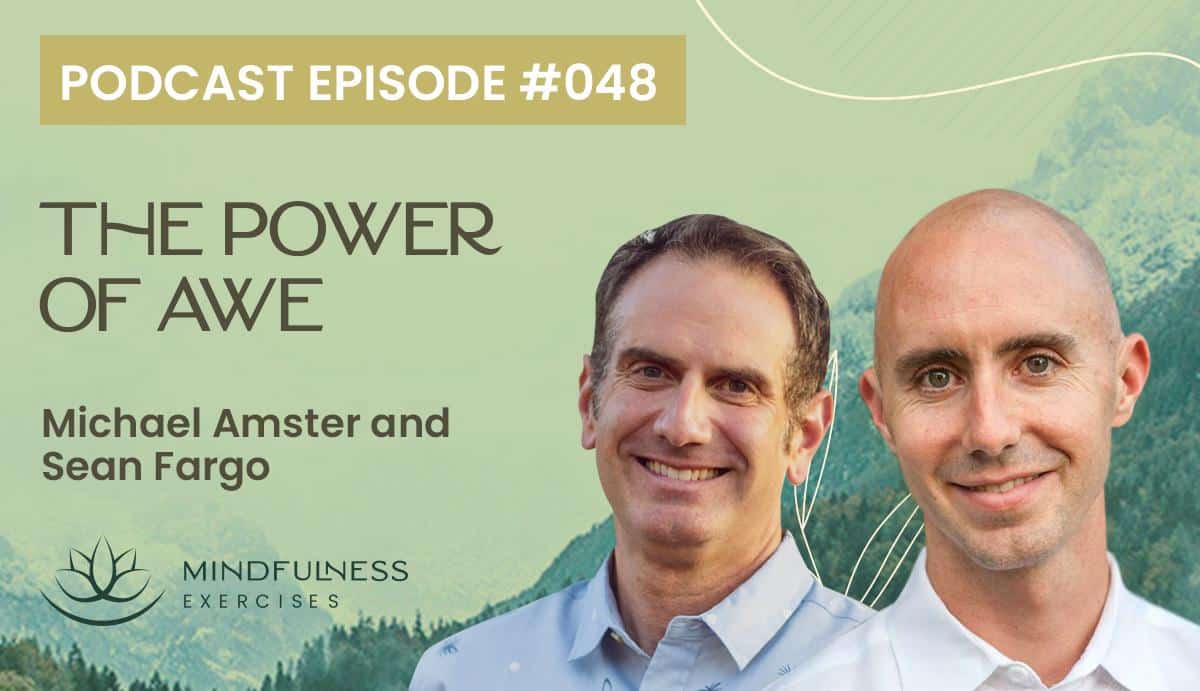Listen now

When was the last time you lost yourself in a moment of awe? For many of us, awe is associated with life’s most significant, profound moments. But awe is ever present and always available, even in the ordinary.
In this episode, we learn about a 15-second practice that can help us become more available for the experience of everyday awe. Research shows that regularly connecting to this unique emotion reduces stress, anxiety, and burnout, minimizes chronic pain, and helps us live with more joy, clarity, ease and wonder.
Listen to Sean Fargo speak with Michael Amster about his new book, The Power of Awe: Overcome Burnout & Anxiety, Ease Chronic Pain, Find Clarity & Purpose - In Less Than 1 Minute Per Day.
Sponsored by our Mindfulness Meditation Teacher Certification Program
MindfulnessExercises.com/Certify
What You’ll Learn in This Episode:
Show Notes & Quotes:
How mindfulness is in constant change
In one sense, mindfulness is classic and unchanging; however, mindfulness also changes, just as we do. In fact, mindfulness - and Buddhism - cannot be separated from the influence of our current culture. So what then is the future of mindfulness, and how is mindfulness practice shifting in a culture that’s dominated by technology, busy-ness and continual movement? Perhaps what we need most today is simple, bite-sized mindfulness practices that fit into our busy lives.
“This is the future of mindfulness. [...] This is it, it’s about how do we apply awe in the everyday? To find awe in the ordinary and not necessarily have to take people into a virtual reality simulator to experience a moment of awe.”
Extraordinary versus everyday awe
The first groundbreaking research on the emotion of awe took place in 2003. In that study, and in most studies since, researchers were curious about what we might now call ‘extraordinary awe.’ But Amster and his team have found that awe happens on a spectrum. It’s also available in ordinary, everyday moments. If we’re mindful and open to our experience, we can witness subtle awe.
“That’s what people think about when they think about awe. They think about, oh I just went to the Grand Canyon and I had that incredible sense of connection to the vastness of the universe or all life looking out over that vista. Or they witness the birth of their child, or they attend the passing of a friend or a loved one and witness someone taking a last breath and have this profound moment of awe and connection to something greater than themselves.”
The immediate reward of everyday awe
As a clinician and pain management specialist who has taught mindfulness to hundreds, Michael has noticed that what his patients struggle with most is finding the time and space to sustain a formal mindfulness practice. The A.W.E. Method, on the other hand, requires just 15 seconds, three times per day, offering near-immediate rewards in very little time. This is very unlike typical concentration practice, for which teachers might say we need to effort our way toward focus.
“It’s not like I’m trying to speed-race to transcendence or anything, but in fact, the less you effort yourself in this practice the more it happens. Whereas, I noticed with my prior times on long retreats, it took a lot of efforting, and almost force in a way, like you’re forcing that concentration.”
The benefit of taking mindfulness off the cushion
Formal mindfulness practice has its benefits, but so too does an integrated practice. Perhaps the latter is more applicable to how we currently live our lives. In addition, brief moments of awareness have the ability to radically shift the central nervous system from sympathetic to parasympathetic dominance. Michael’s studies have found that even 15 seconds of practice in the morning can help us respond differently to the stressors we face throughout the day.
“With our busier lives than ever, and the technology that we’re connected to, I think more than ever, these types of practices, these informal practices, are more important.” [...] For the average family-holder out there in the world that has kids and jobs and the busy-ness, it’s wonderful to take mindfulness out to the airport. When you’re in line at the TSA checkpoint you can have a moment of awe and mindfulness, like, a profound moment of awe, actually.”
The results of two studies on the benefits of A.W.E.
During the pandemic in 2020, Michael and his co-author, Jake Eagle, organized two studies to test the effectiveness of their 21-day A.W.E. Method. One of these studies followed doctors and nurses on the front lines of the COVID-19 crisis. They found that their technique was so effective at reducing stress, anxiety and depression, that it statistically qualified as a medical intervention.
“We saw decreases in loneliness, which is really interesting, because people were sheltering in place and alone. But there’s something unique, and what makes awe such a special emotion, is that it connects us to the vastness, the grandeur of all life. And so, we don’t feel alone when we have a moment of awe. We feel a connection. Even if we’re sitting by ourselves, we still feel connected.”
The power of identifying with something bigger than ourselves
Many of those who experience chronic pain, including depression or a chronic illness, have a habitual tendency to over-identify with their pain. This identification (my pain, my pills, my morphine) can intensify the experience of pain and make letting go more of a struggle. But in the midst of awe, our egoic identity softens. Connecting with something greater than ourselves allows us the spaciousness in which to change.
“What’s beautiful is you can have awe moments in the midst of chronic pain or depression and it does shift your physiology and your nervous system, and it does change one’s egoic identity and self, even gradually over time. And with sustained practice, it makes a significant change. [...] That we have the capacity to be in awe when experiencing difficult emotions gives us a great deal of influence over our suffering.”
How to practice the A.W.E. Method
Michael’s A.W.E. Method creates an acronym out of the word ‘awe’ to remind us of the 3-step process. A is for attention. For 1-2 cycles of breath, we bring our full attention to something we value, appreciate or find amazing. W is for wait. By waiting a moment, we allow for presence and connection with what we find special. E is for exhale and expand. We take a full breath out and sense the expansion of energy.
“So really what the A.W.E. Method is about is giving people these training wheels to begin cultivating a practice of awe where any object can become an extraordinary source of inspiration, beauty, of awe, of wonder for us. And so we’re building this muscle up. We’re building selective perception so we can have the ability to really walk through the world every day with a sense of wonder and awe with everything that we can touch.”
How mindfulness invites awe in
What seems ordinary becomes extraordinary the more we pay attention to it. This simple truth can help us remember that just opening our awareness and becoming more mindful of our surroundings allows us to access awe. And, the more we build the awe muscle, the more we establish the conditions that allow for awe to naturally arise.
“Just be receptive, and open to this field of consciousness and of energy and the vastness of all life on this planet. And when we create that, it’s like, then the awe just bubbles up, it arises in the field of awareness, this awe. I mean, everywhere there’s awe to be had. [...] We forget that we’re alive and there’s wonder and amazement to be had at every moment.”
Additional Resources:

About Michael Amster:
Dr. Michael Amster is a family physician, faculty member at the Touro School of Medicine, and founding director of Santa Cruz Community Health. As a pain management specialist, he has helped hundreds find relief from chronic pain with a combination of traditional and holistic medicine, leaning on his experience as a clinician, 30-year meditation student, yoga and mindfulness teacher, trained at Spirit Rock Meditation Center.
His book, The Power of Awe: Overcome Burnout & Anxiety, Ease Chronic Pain, Find Clarity & Purpose - In Less Than 1 Minute Per Day, is the culmination of his research into the emotion of awe. The book describes an extraordinary yet simple mindfulness practice that turns ordinary moments into awe-inducing experiences, helping us effortlessly achieve a heightened state of consciousness and live with greater wonder, joy, peace and ease.
A native Californian, Michael was born and raised in San Diego, earned his undergraduate degree from UC Santa Cruz and his medical degree from UC Irvine, and completed his residency at UC Davis. In his free time, he can be found in the water, either surfing, ocean swimming, sailing, or paddleboarding.



